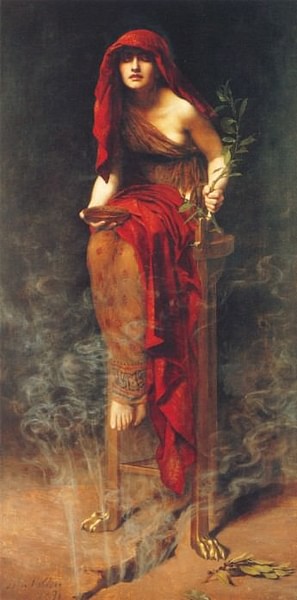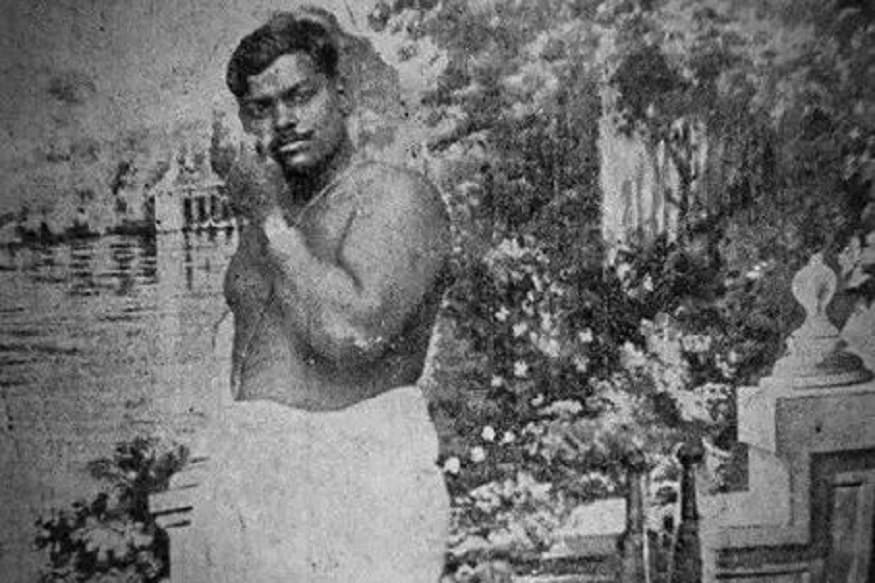Ah… the holy cleric… The support caster of support casters at the beck and call every wounded warrior. They are squeamish around blood, in chapel on a friday night, and rolling their eyes at every joke. And for most people, no matter how powerful the class is (and it is VERY powerful) that sounds… boring.
It’s a problem the class has faced since the first edition. The stereotypical life cleric dwarf isn’t appealing to everyone. But with an immense amount of subclasses and deities, clerics are much more versatile than people think. With enough creativity, you can make this super powerful class look however you want.
With that in mind, here are 7 unique clerics from history as inspiration. Cleric’s that hardly match the stereotype of “the pious, feeble priest”
The Pythia – 8th Century AD – (Arcana Domain)

Our first cleric, “The Pythia”, is actually a title, awarded to one of the many virgin priestesses of the Oracle of Delphi. The Oracle was a temple that provided authoritative (and ambiguous) answers to the serious Greek questions of destiny and war. These women were chosen from the best families of Delphi, receiving honor, wealth, responsibilities, and freedoms withheld from all other women in Greek culture. So why was the Pythia one of the most powerful women in the ancient world? Because she could channel the will of the god Apollo!
To prepare to be a vessel of Apollo, the Pythia followed a sacred rite. After a purification period of fasting and bathing in the Castalian Spring, the Pythia would don a white dress and enter the temple. If the omens from a sacrificed goat were favorable, she would then enter the chamber (the “adyton”) and sit on a tripod chair over the crack in the earth that the “divine fumes” poured out. Upon inhaling the fumes, she would enter a semi-conscious trance and respond to questions from eager Greeks, sometimes in coherent poetry and other times with wailing gibberish.
While scientists speculate that the fumes were likely ethylene, methane and ethane gas, your cleric can certainly breathe in fumes of Avernus or Celestia, and be the only “unconscious” member of your party to thrive in combat!
Judas Maccabeus (died 160/161 BCE) (Tempest Domain)
The emperor of the Greek Selucids, Antiochus IV Epiphanes, was determined to unify his kingdom under Greek culture. So in 175 BCE, he embarked upon a cultural genocide of the Jewish people. He prohibited Judaism, massacred resisting clerics, and desecrated Yahweh’s temple. Yet in 63 BCE, when the Roman Empire arrived, the Jews were a fully independent kingdom. How? Because Antiochus got “hammered” by a unique cleric, Judas Maccabeus.
Inspired by the prophets of old, Judas Maccabeus launched a revolt and quickly proved to be an exceptional guerilla tactician and warrior. Beginning in 167 BCE, he led bands of Jewish patriots through the hills, avoiding pitched battles and ambushing every chance he got. I His victories and numbers grew, culminating in the recapture of the capital city, Jerusalem. Ever the faithful cleric, he cleansed the temple, and rededicated it to Yahweh with sacrifices, a victory celebrated annually by Jews as Hannukka: the Festival of Lights.
Fun fact: in an early encounter, he killed the governor of Samaria and forever after used his captured sword as a symbol of vengeance. That’s one way to have your cleric wield a sword rather than a war hammer!
Julius Caesar – 100 BCE – 44 BCE (War Domain)
Though forever hailed as one of the greatest generals ever, for a time Caesar was most important religious figure in all of Rome! Admittedly, its strange that Caesar was the cleric responsible for regulating public morals. After all, he was A) a womanizer on par with James Bond, B) one of the greatest military minds ever, C) a fashion-forward trend setter, D) a savvy politician, and E) a genocidal maniac (especially when it came to Celts).
Before Caesar could command armies, he needed to ascend the political ladder. For the Romans, everything political was simultaneously religious, and so Caesar’s first big break was that of Pontifex Maximus, the cleric of cleric’s in all of the Roman Republic. As Pontificus Maximus, Caesar was charged with maintaining the pax deorum (“peace of the gods”). He did this largely administratively, overseeing regulation of ceremonies, the calendar, and consecration of all sacred places.
But if you are inspired, you might need to change one tradition for a wandering adventurer: the Pontifex Maximus was not allowed to leave Italy!
Pope Sergius III 860 AD – 911 AD (Death Domain)
For the Catholic Church, no cleric is higher than the pope. Though vaguely claiming to “lead the faithful”, in reality he has more power than any religious figure in the world. By his word bishops are elected, world wide councils called, and, on special occasions, he speaks with the authority of God. Every pope is required to be celebate, devoted to Christ and his church, full of love, humility, and wisdom. In Catholic history, a few pope’s are canonized saints, while most pope’s are considered good or bad. But few were downright wicked… like Pope Sergius III.
That’s the reputation you get when the church under your watch is referred to as “house of harlots”. Fully complicit in the power politics of Italy during his time, he was placed on the papacy by his benefactor Theophylact so that the papacy’s resources could be committed to his murders and wars. At best, modern historians refer to him as man lacking Christian virtue. But on the other hand, he is called a wretch, malignant, ferocious, a monster… it goes on and on.
So if you want a unique cleric, do what Sergius did before you join a party: strangle BOTH your holy predecessors and go adventuring without a care in the world!
Al-Ghazali 1058 AD – 1111 AD (Knowledge Domain)
History’s list of ‘smart humans’ is full of clerics from all sorts of religions. But Islam lays the unique claim for founding the first place exclusively for smart people: the university/mosque of al-Quarawiyyin, formed in 859 AD in Morocco. Established during the “Islamic Golden Age”, intellectual centers like these flourished in pursuit of classical Greek knowledge. The age yielded geniuses like Ibn Rushd (Averroes), Ibn Sina (Avicenna), and inspired the Renaissance thinkers of Europe. But arguably, none of that would be the case without the Imam (Islamic cleric), Al-Ghazali.
Called the “Brilliance of the Religion” Al-Ghazali was a unique individual who sought spiritual fulfillment, wisdom, AND knowledge. Across 70 works he discussed early childhood development, education, law, philosophy, spirituality, economics, theology, spirituality, and legal theory. His most famous work promoted a form of “theological occasionalism”: the belief that the reactions we see in nature, like lighting a candle, fundamentally occur because God wills it. To our modern ears, that sounds a bit ridiculous. But in his medieval world, it blended religion and secular study into a harmony, ushering in an age where philosophy and science were free to thrive.
Needless to say, a Al-Chazali inspired cleric might need their knowledge stat to be higher than wisdom!
St. Francis of Assisi – 1181 AD -1226 AD (Nature Domain)
In many ways, St. Francis of Assisi had a life that mirrored many Catholic saints: born into a wealthy family (check)… grew disillusioned with wealth (check)… turned his attention to spiritual matters (check)… devoted himself to a life of simplicity and prayer (check). All the boxes checked. But the gentleness, love, and simplicity of this cleric attracted others and exploded into the famed Fransicsan Order. But that wasn’t enough for St. Francis: he also tried to end the crusades by converting a freaking Sultan, and just prior to his death received “the stigmata”: the wounds of Christ on your hands, feet, and sides. Ya know, normal cleric stuff.
But on 29 November 1979, St. Francis was named the patron saint of… ecology. Why? Because he also LOVED nature. He regarded all creatures, not just people, as brothers and sisters. His legends include him preaching to birds and quelling the dispute between a wolf and a local village. To this day, many present their pets to their local priest to be blessed on St. Francis’ feast day! And for Christmas lovers out there: we have him to thank for the first live nativity scene in 1223 AD.
So if someone tells you to play a Druid instead, tell them you’d rather be a cleric who worships a god AND is one with nature.
Chandra Shekhar Azad (Hindu) – 1906-1931 (Trickery Domain)
And finally, a modern cleric! Though an avowed atheist, Chandra Shekhar Azad did belong to the Brahmin caste: the clergy and highest caste within the Varna Caste System. Along with being advisors to kings, the Brahmin are the pujari (priests) that care for Hindu temples, perform offerings, and conduct ceremonies. Traditional Brahmin wear the spotless “sacred thread”, showing they maintain the highest purity standards through regular washing and vegetarianism. The Vedas, most ancient and sacred of texts in the Hindu religion, are memorized in Sanskrit and recited in hymns.
But Chandra Shekhar Azad’s heart rested in politics, not religion. He passionately opposed the social divides that promoted exploitation of fellow humans, and as a young man led “funding campaigns” for a nationalistic political group. And by “funding” I mean theft and robbery, including the infamous Kakori Train Robbery in 1925 and the attempted bombing of the Viceroy of India’s train in 1929. For 6 years, as the leadership was hunted down by British authorities, Azad hid by using numerous disguises, such as a beggar or a mechanic. During this time he nearly single handedly reorganized the party, strengthening its numbers and giving it a socialist, anti-caste purpose. He was immortalized by patriotic Indians when, refusing to be taken alive, he used his last bullet on himself in a shootout in Alfred Park, 1931.
History teaches us lessons: just because you are a trickster cleric doesn’t mean you can’t serve a higher cause than wealth!
There you have it: 7 unique cleric’s from history to inspire your next PC. Hopefully it is abundantly clear: there are A LOT of ways to play a cleric.
But I didn’t come close to covering them all. What are some alternatives for the domain’s listed? And for the domains I missed, what are you hoping I will touch on next time? Comment below and let us know!
Discover more from The Daily Dungeon Master Blog
Subscribe to get the latest posts to your email.







